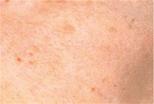What are Age Spots on your arms?
 Little dark patches similar to large freckles appearing on your skin that were not there before – they seem to pop up overnight? Welcome (or not) to age spots.
Little dark patches similar to large freckles appearing on your skin that were not there before – they seem to pop up overnight? Welcome (or not) to age spots.
At first you may worry that these could be cancerous growths but age spots (see how to spot them below) are not malignant. However, if you are concerned about any new skin blemishes always ask your doctor to give them the once over.
Who is most likely to get Age Spots?
Women in their 40's are more likely to develop age spots, although younger people may sometimes develop them as well. These dark patches on the skin are also known as "solar lentigines" "liver spots” and are sometimes referred to as "pigmentation”
How to recognise Age Spots
Age spots, pigmentation marks, freckles are oval in shape and are flat. Freckles or age spots can vary in size; the latter can appear grouped together, which makes them look larger than individual dark patches.
Where on the body are they most likely to appear?
Age spots may be present on those parts of the body that have been most exposed to the sun. You may notice them first on the backs of hands, then the face, arms and torso especially the breast bone area where your shirts are open in summertime.
What is the difference between Age Spots and Moles?
 Age spots are not the same thing as moles. A mole on the skin is another example of a benign skin growth. They may be dark brown or black in colour and may appear anywhere on the body. Any changes to moles must be looked at by a doctor.
Age spots are not the same thing as moles. A mole on the skin is another example of a benign skin growth. They may be dark brown or black in colour and may appear anywhere on the body. Any changes to moles must be looked at by a doctor.
Most of the time moles appear in the first 20 years or so of life. Age spots usually appear in middle age or later. However the mole you have lived happily with for years may change in appearance; they may become raised or have hairs growing out of them. But, we cannot repeat enough that any changes must be seen by a doctor.